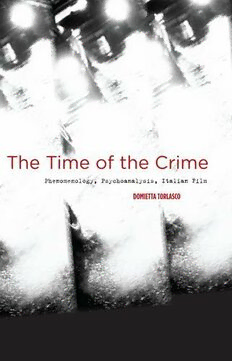
The Time of the Crime: Phenomenology, Psychoanalysis, Italian Film PDF
Preview The Time of the Crime: Phenomenology, Psychoanalysis, Italian Film
The Time of the Crime The Time of the Crime Phenomenology, Psychoanalysis, Italian Film Domietta Torlasco Stanford University Press Stanford, California Stanford University Press Stanford, California © 2008 by the Board of Trustees of the Leland Stanford Junior University. All rights reserved. No part of this book may be reproduced or transmitted in any form or by any means, electronic or mechanical, including photocopying and recording, or in any information storage or retrieval system without the prior written permis- sion of Stanford University Press. Printed in the United States of America on acid-free, archival-quality paper Library of Congress Cataloging-in-Publication Data Torlasco, Domietta, 1968- The time of the crime : phenomenology, psychoanalysis, Italian film / Domietta Torlasco. p. cm. Includes bibliographical references and index. ISBN 978-0-8047-5802-4 (cloth : alk. paper) 1. Detective and mystery films--Italy--History and criticism. 2. Time in motion pictures. I. Title. PN1995.9.D4T67 2008 791.43'6556--dc22 2008006699 Designed by Bruce Lundquist Typeset at Stanford University Press in 11/13.5 Adobe Garamond Contents Acknowledgments vii Introduction 1 1 The Scene of the Crime 15 “X Marks the Spot” 15 Blow-up: Returning to the Scene of Perspective 19 The Passenger: Vanishing 36 2 Desiring Death 41 Intermittence 41 The Night Porter: The Metamorphosis of the Crime Scene 45 The Detective and the Witness 56 3 Seeing Time 64 Skins of Color 64 Oedipus Rex: The Depth of the Crime Scene 69 The Face and the Landscape 77 4 Twilight 87 The Line and the Labyrinth 87 The Spider’s Stratagem: The Truth of the Crime Scene 92 Notes 113 Index 129 Acknowledgments I wroTe ThIs book DurIng my appoInTmenT as a Harper- Schmidt Fellow and a Collegiate Assistant Professor in the Humanities at the University of Chicago but developed its blueprint while at the University of California, Berkeley. My gratitude goes to Kaja Silverman, Judith Butler, Barbara Spackman, and Anton Kaes, who inspired and supported my work as a doctoral student in the Department of Rhetoric. Kaja Silverman provided invaluable guidance on my dissertation as well as precious institutional assistance. The rigorous and adventurous close readings that distinguish her seminars were for me a decisive experience. I especially wish to thank Judith Butler, who first spoke to me of a book and offered, together with the most lucid insights, constant encourage- ment and advice. My gratitude also goes to the friends and colleagues who read different parts of this work and responded with remark- ably smart and helpful comments—Homay King, Greg Forter, Lynne Layton, Sharon Willis, Patricia White, and Vivian Sobchack. I also wish to thank Norris Pope and Emily-Jane Cohen, for their interest in the project and professionalism; the Stanford University Press readers, for their generous and thought-provoking insights; Mariana Raykov, who patiently guided me through the last steps of the publication process; and Andrew Frisardi, who edited the manuscript with such a careful hand. I am deeply grateful to Scott Combs, for our interminable discus- sions on cinema and death; to Theresa Schwartzman, who brilliantly ed- ited the last chapter; to Nasrin Qader and Susan Gayle Levine, for their friendship and counsel during the last phases of the composition process; to Frida Ravasi, my first mentor; and to A. B. Scott. Special thanks to my family, particularly to my sister Diletta. viii Acknowledgments A shorter version of Chapter 1 appeared in Camera Obscura 22, no. 1 64 (2007): 77–111; and a shorter version of Chapter 2 appeared in Psycho- analysis, Culture, and Society 10 (August 2005): 138–50, and in Desire of the Analysts: Psychoanalysis and Cultural Criticism, ed. Paul A. Miller and Greg Forter (Albany: State University of New York Press, 2008). I thank the editors for permission to reprint. The Time of the Crime
